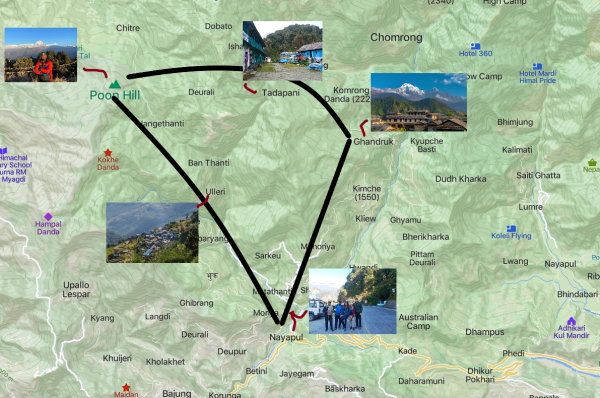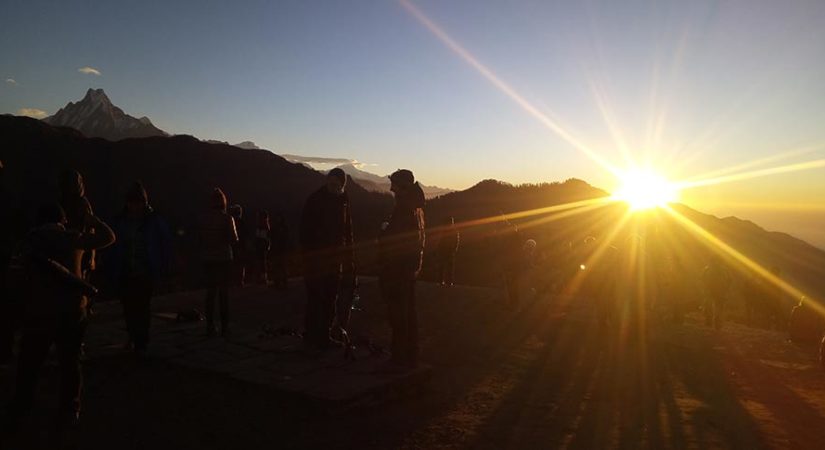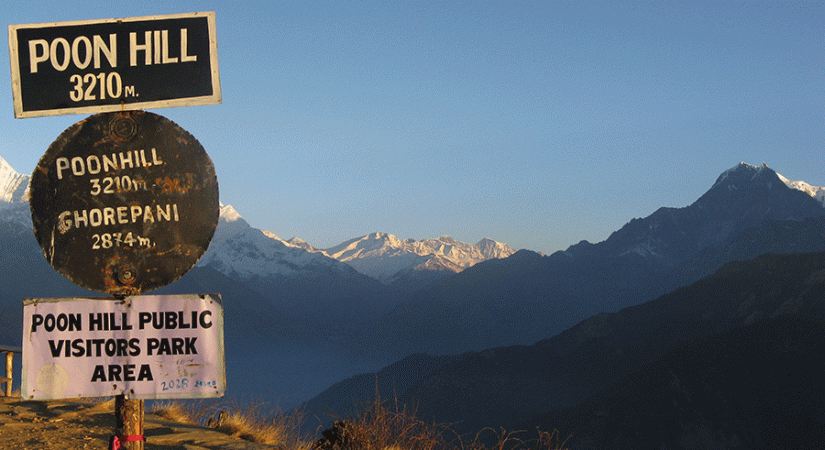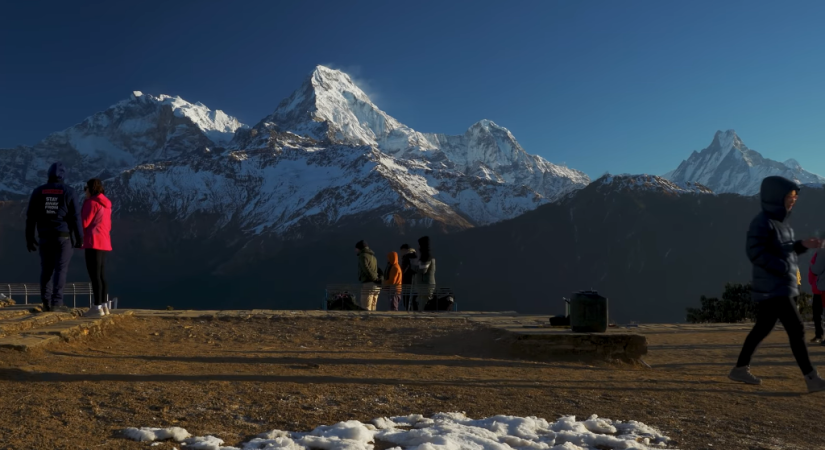POKHARA-NAYAPUL-THIKHEDUNGA-ULLERI-GHOREPANI-POONHILL-BANTHATI-NAYAPUL-POKHARA
Why Poon Hill Trek 3 days?
- Stunning sunrise and sunset views over the Himalayan mountain range.
- A shorter and more manageable trek for those with limited time.
- Accessible for beginner trekkers who want to experience trekking in Nepal.
- Beautiful natural scenery along the trekking trail, including rhododendron forests and waterfalls.
- Opportunity to experience local culture and interact with locals in traditional villages.
- Affordable cost compared to longer and more challenging treks in the region.
- The trek is open all year round, except during heavy snowfall in winter.
- Fewer crowds and quieter trails than some of the more popular treks in the region.
- Chance to challenge yourself physically and mentally in a beautiful natural setting.
- The sense of achievement and satisfaction that comes with completing a trek in the Himalayas.
Poon hill Trek 3 days Route Overview:
The Poon Hill Trek 3 days is a 40km/25mi route that takes 3-4 days to complete. A licensed guide is mandatory and permits are required. The trek starts at Nayapul-1075m, 2 hours from Pokhara and ends at Ghandruk-1850m. Poon Hill (3131m) is the highest point with a total ascent of 3000m and descent of 1996m. Accommodation is available at Guesthouses, with food options including Nepali, Chinese, and Western cuisine. The average cost is US$25-30 per person per day.
Poon hill Trek 3 days route Information in details
Poon Hill Trek 3 days is a popular and relatively easy trek in the Beautiful Annapurna region of Nepal. It is named after Poon Hill, which is a viewpoint located at an altitude of 3,210 meters (10,531 feet) above sea level, offering breathtaking views of the Himalayas. The trek is known for its scenic beauty, cultural diversity, and stunning mountain views, making it a great option for beginner trekkers or those with limited time.
The trek typically starts from the town of Nayapul and follows a well-trodden path through charming villages, lush forests, and rhododendron-filled hillsides. Along the way, trekkers pass through several traditional Gurung and Magar villages, where they can experience the local culture and hospitality. Magar, one of the major ethnic groups of Nepal, has a significant presence in this region and has their own unique traditions and customs.
One of the best times to do the 3 Days Poon Hill Trek is from March to May and September to November, when the weather is dry and the skies are clear, providing the best views of the mountains. The trek can be done in a variety of ways, including the Short Ghorepani Trek, which takes about 4-5 days, or the 3 days Poon Hill Trek from Pokhara. The Short Poon Hill Trek itinerary typically includes a visit to the beautiful village of Ghorepani, known for its charming atmosphere and stunning mountain views.
The trek is easily accessible from Kathmandu, and there are several ways to get to the starting point in Nayapul. One option is to take a bus from Kathmandu to Pokhara and then a jeep or taxi to Nayapul-1075m. Another option is to take a flight from Kathmandu to Pokhara and then a taxi to Nayapul.
For those on a budget, the Poon Hill Trek 3 days is an affordable option, with relatively low costs for accommodation, food, and transportation. The height of Poon Hill makes it a perfect spot to watch the sunrise over the Himalayas, creating an unforgettable experience for trekkers.
Prepare for Poon Hill Trek 3 days
Preparing for a Ghorepani Poon Hill Trek in 3 days requires physical fitness, appropriate clothing and equipment, and proper planning. It is recommended to engage in regular exercise and walking in the weeks leading up to the trek to improve endurance. Weather conditions in the region can be unpredictable, so carrying waterproof and warm clothing is essential. Proper trekking equipment like sturdy shoes, backpack, and trekking poles should also be carried. Staying hydrated by carrying enough water and electrolytes is crucial, and carrying some snacks can provide energy during the trek. Proper planning, booking a reliable tour operator like Nepal Everest Guide, and obtaining necessary permits beforehand can make the trekking experience safe and enjoyable.
Best Time to Trek Poon Hill: A Month-by-Month Guide
The best time to trek Poon Hill is during the Spring (March to May) and Autumn (September to November) seasons. During these months, the weather is generally stable, with clear skies and moderate temperatures. The spring season is known for blooming rhododendron flowers and lush greenery, while the autumn season is known for clear snow cap mountain views and comfortable trekking weather. December to February is also a good time to trek, with less crowded trails, but it can be very cold and snowy. The monsoon season (June to August) is not recommended for trekking due to heavy rain and landslides.
Poon Hill Trek Weather: What to Expect During Your Trek
Poon Hill Trek 3 days weather can vary depending on the season and altitude. The spring season (March to May) is generally mild with moderate temperatures, while the autumn season (September to November) is dry with cool temperatures. The winter season (December to February) can be cold with the possibility of snowfall, especially at higher altitudes. The monsoon season (June to August) brings heavy rainfall and muddy trails, making trekking difficult. It is important to carry appropriate clothing for varying weather conditions, including warm layers, waterproof jackets, and hats and gloves. Additionally, it is recommended to check weather forecasts regularly and to follow the guidance of local guides for safe trekking.
Best Accommodation Options on Poon Hill Trek: Tea Houses and Lodges
The 2 night 3 days Poon Hill trek offers a range of accommodation options, primarily tea houses and lodges. Tea houses are small, family-run establishments that offer basic facilities such as shared bathrooms and simple bedding. They also serve traditional Nepali Local food and hot drinks. Lodges are slightly more developed with private bathrooms and comfortable bedding, often with additional amenities such as hot water and Wi-Fi. They may also offer more extensive menus with international cuisine. Both options offer an authentic and immersive experience of Nepali culture and hospitality. It is recommended to book accommodations in advance, particularly during peak trekking seasons. Tour operators like Nepal Everest Guide can assist with booking accommodations along the trekking route.
Poon Hill Trek 3 days Outline
Day 1: Nayapul to Ulleri (8.5 km / 5-6 hours)
Day 2: Ulleri to Ghorepani (9 km / 4-5 hours)
Day 3: Ghorepani to Poon Hill to Nayapul (12 km / 6-7 hours)

What's included?
What's not included?
Day by Day Itinerary
DAY
1
Nayapul to Ulleri- 8.5 km
5-6 hours Breakfast, Lunch & Dinner Guest House
You'll start your trek from Nayapul, a small town located about an hour's drive from Pokhara. From Nayapul, you'll follow the Modi Khola river, passing through beautiful villages and terraced farmlands. The trail gradually ascends towards Ulleri, a small village located at an altitude of 2,050 meters. Along the way, you'll see stunning views of the Annapurna and Dhaulagiri mountain ranges. You'll spend the night at a tea house in Ulleri.
DAY
2
Ulleri to Ghorepani - 9 km
4-5 Hours Breakfast, Lunch & Dinner Guest House
On the second day, you'll continue your trek towards Ghorepani, another beautiful village located at an altitude of 2,750 meters. The trail passes through dense forests of rhododendron and oak trees, offering beautiful views of the surrounding mountains. You'll also see several waterfalls along the way, including the popular Bhurungdi Khola waterfall. You'll spend the night at a tea house in Ghorepani.
DAY
3
Ghorepani to Poon Hill to Nayapul-12 km
7 Hours Breakfast, Lunch & Dinner Guest house
On the final day, you'll wake up early in the morning and hike up to Poon Hill to catch the sunrise over the Himalayas. The hike to Poon Hill takes about 45 minutes and is well worth the effort. From Poon Hill, you'll see stunning panoramic views of the Annapurna and Dhaulagiri mountain ranges. After enjoying the sunrise, you'll hike back down to Ghorepani for breakfast and then continue your trek back to Nayapul. From Nayapul, you'll drive back to Pokhara.
Nepal Everest Guide is a well-known tour operator in Nepal that can help you organize your Poon Hill Trek. They offer a wide range of trekking packages, including private and group tours, and can customize their itineraries to fit your needs and preferences. Their experienced guides will ensure that you have a safe and enjoyable trekking experience in the beautiful Annapurna region of Nepal.
Departure Dates
Sorry, No fixed departure dates are listed to group join, please request private trip
"Escape to the natural beauty of Poon Hill with Nepal Everest Guide's 3-day trek package. Immerse yourself in the stunning landscapes of the Annapurna region and witness the majestic peaks of the Himalayas. With our expert guides, comfortable accommodation, and delicious Nepali cuisine, you can fully focus on enjoying the beauty of this incredible trek. Book now and take advantage of our limited-time offer for an unforgettable adventure. Contact us for a personalized quote and get ready to embark on the trek of a lifetime!"
Reviews

Alejandro Roman
Canada
Memorable Hike: What Made My 3-Day Poon Hill Trek an Exceptional Expedition
2022, DecemberWow a best trip Ever!!!
The three-day Poon Hill trek with Ram was an unforgettable experience that left an indelible impression on me. The landscape was a stunning combination of verdant gardens, dense forests, and breathtaking alpine views that took my breath away. However, what truly set the journey apart was Ram’s exemplary leadership skills. His extensive experience put everyone at ease, and his familiarity with the mountains was second to none. He was always ready with detailed responses to our queries, which was impressive. His compassion and friendly demeanor made the trip all the more enjoyable, and we were grateful to have him as our guide.
Alejandro Roman
Dhat Bhat Power 24 Hour-NEPAL!!!
Essential Information
Poon hill Trek Difficulty
The Poon Hill trek is considered a moderate trek with some challenging uphill sections. The trail is well-maintained and relatively easy to follow, but there are some steep ascents and descents, especially on the second day of the trek. The highest point on the trek is Poon Hill, which is at an altitude of 3,210 meters, and some trekkers may experience mild altitude sickness symptoms such as headache or fatigue. However, with proper preparation and acclimatization, most trekkers should be able to complete the trek without any major issues. It is recommended to have a moderate level of fitness and endurance to fully enjoy the trek.
Entry permit for Poon hill trek
To trek in the Annapurna region, including the Poon Hill trek, you need to obtain two permits: the Annapurna Conservation Area Permit (ACAP) and the Trekkers’ Information Management System (TIMS) card.
The ACAP is a permit that allows you to enter the Annapurna Conservation Area, which is a protected area that covers more than 7,600 square kilometers of land. The permit costs around $30 USD for foreign nationals and can be obtained at the Nepal Tourism Board in Kathmandu, Pokhara, or at the entry point of the trekking trail.
The TIMS card is a trekking registration card that helps to keep track of trekkers and ensures their safety. It costs around $10 USD for individual trekkers and $20 USD for trekkers traveling in a group. You can obtain the TIMS card at the Trekking Agencies' Association of Nepal (TAAN) office in Kathmandu or Pokhara, or at the entry point of the trekking trail.
It is important to obtain both permits before starting the trek, as there are frequent checkpoints along the trekking route where you will be asked to show your permits.
What kind of Trekking Arrangements do We Provide?
Nepal Everest Guide provides a comprehensive range of trekking arrangements to ensure that you have a comfortable and enjoyable trip. Here are some of the things that we provide:
- Experienced trekking guides: Our experienced and knowledgeable trekking guides will accompany you throughout your trek, providing valuable insights into the local culture, history, and geography of the area.
- Accommodation: We provide comfortable and clean accommodation in tea houses and lodges along the trekking route.
- Transportation: We arrange transportation to and from the trekking trailhead, either by private vehicle or public transportation.
- Permits and paperwork: We take care of obtaining all necessary trekking permits and paperwork, including the Annapurna Conservation Area Permit (ACAP) and the Trekkers’ Information Management System (TIMS) card.
- Meals and water: We provide three nutritious meals a day along with boiled or purified water to ensure that you stay healthy and well-nourished throughout your trek.
- Safety equipment: We provide essential safety equipment such as first aid kits, oxygen cylinders, and communication devices.
- Porter service: We can arrange for porter service to carry your luggage and lighten your load.
- At Nepal Everest Guide, we strive to make your trekking experience as comfortable and enjoyable as possible. We take care of all the details, leaving you free to focus on the stunning scenery and amazing cultural experiences that the Poon Hill trek has to offer.
Poon Hill Trek packing list
When packing for the Poon Hill Trek, it's important to bring the essentials while keeping your pack as light as possible. Some key items to consider include:
- Good quality hiking boots
- Warm layers for cold nights
- Lightweight, quick-dry clothing for hiking
- Rain gear
- Sun protection, including a hat and sunscreen
- First aid kit
- Headlamp or flashlight
- Trekking poles
- Water bottle and water purification tablets
- Personal toiletries, including hand sanitizer and wet wipes. Keep in mind that you'll be staying in tea houses, so you won't need to carry a tent or sleeping bag. Packing smartly will ensure you have everything you need without weighing you down on the trail.
Poon Hill Trek Solo vs. Guided Trek: Which Is Better?
Deciding between a solo or a guided trek for Poon Hill can depend on various factors such as experience, budget, and personal preference.
Solo trekking can offer a sense of freedom and independence, but it requires a certain level of experience and preparation. You need to plan your itinerary, arrange necessary permits and accommodations, and be self-sufficient during the trek.
On the other hand, a guided trek offers several advantages such as having an experienced guide who knows the route, can provide insights into the local culture and environment, and can assist in case of emergencies. Moreover, with a guided trek, your accommodations and meals are taken care of, and you can have a more organized and stress-free experience.
Overall, if you are an experienced trekker and confident in your abilities, solo trekking can be an option. However, if you are new to trekking or want a more organized and comfortable experience, a guided trek with a reputable company like Nepal Everest Guide is highly recommended.
How to Get to Nayapul for Poon Hill Trek
Nayapul is the starting point for the Poon Hill trek, and it is located about an hour's drive from Pokhara, a popular city in Nepal. Here are some ways to get to Nayapul for the Poon Hill trek:
- Private Car or Jeep: You can hire a private car or jeep from Pokhara to Nayapul. This is a convenient option as you can choose your own pick-up time and the car will drop you off at the trekking starting point.
- Public Bus: You can take a public bus from the Pokhara bus station to Nayapul. Buses depart frequently, and this is a budget-friendly option.
- Shared Jeep: You can also take a shared jeep from Pokhara to Nayapul. This is a cost-effective option as the fare is shared among the passengers.
It is recommended to book transportation in advance, especially during peak trekking seasons. Additionally, it's important to note that the road to Nayapul is bumpy and winding, so be prepared for a rough ride.
Make Sure you are Safe during the 3 days poon hill Trek
Trekking in the mountains can be a wonderful experience, but it is important to take safety precautions to ensure that you have a safe and enjoyable journey. Here are some tips to help you stay safe during your 3-day Poon Hill trek:
- Hire a Guide: It is always recommended to hire a guide who is familiar with the trail and can help you in case of an emergency.
- Acclimatize Properly: Altitude sickness can be a real danger, especially if you are not used to trekking at high altitudes. It is important to take your time and acclimatize properly before attempting to climb higher.
- Stay Hydrated: Dehydration can be a problem at high altitudes, so make sure you drink plenty of water throughout your trek.
- Dress Appropriately: The weather in the mountains can be unpredictable, so make sure you bring appropriate clothing for all types of weather conditions.
- Pack a First Aid Kit: It is always a good idea to pack a small first aid kit with essentials such as bandages, pain relievers, and any necessary medications.
- Be Aware of the Trail: Make sure you are aware of the trail and any potential hazards such as steep drops, loose rocks, or slippery surfaces.
- Stay on the Trail: Always stay on the marked trail to avoid getting lost or injured.
- Carry Enough Food: Make sure you carry enough food for your trek. Eating well can help you stay energized and avoid fatigue.
- Stay Connected: It is a good idea to bring a mobile phone and keep it charged in case of an emergency.
- Respect the Mountains: Remember that the mountains are a fragile environment and should be treated with respect. Do not leave any trash behind and do not damage any vegetation or wildlife.
Budget poon hill trek
Budget Poon Hill trek is a great option for travelers who want to experience the beauty of the Himalayas without breaking the bank. There are several ways to keep costs low during the trek.
- Choose the right season: The low season (July-August and December-February) has fewer tourists and lower prices for accommodation and food.
- Join a group tour: Group tours are usually cheaper than hiring a private guide, as the cost is shared among the group members.
- Stay in tea houses: Tea houses are basic but comfortable accommodations that are available along the trekking route. They are cheaper than lodges and hotels.
- Bring your own snacks: Bring your own snacks such as energy bars, nuts, and dried fruits to avoid buying expensive snacks along the way.
- Bargain: Bargaining is common in Nepal, so don't be afraid to negotiate prices for food and accommodation.
- Walk-in: Pre-booking accommodation can be more expensive than walking in and negotiating directly with the tea house owner.
- Use local transport: Public buses are much cheaper than private transportation. From Pokhara, you can take a bus to Nayapul to start your trek.
By following these tips, you can enjoy a budget-friendly Poon Hill trek without compromising the quality of your experience.
Total ascent on the Poon Hill trek
The total ascent on the Poon Hill trek varies depending on the starting point and the route taken, but it typically ranges between 3,500 and 4,000 meters (11,500-13,100 feet). The ascent is spread out over the course of the trek, with daily gains of around 1,000 meters (3,280 feet) in elevation. The steepest part of the ascent is the climb up to Ulleri, which involves a staircase of over 3,000 steps. It's important to take your time and acclimatize properly to avoid altitude sickness, which can be a serious concern at higher elevations.
Total descent on the 3 days Poon Hill trek
The total descent on the Poon Hill trek over 3 days depends on the route taken, as there are multiple options for descending. One common descent route is from Poon Hill to Ghorepani, which involves descending about 300 meters (984 feet) from the peak of Poon Hill to Ghorepani. On the second day, trekkers typically descend about 850 meters (2,788 feet) from Ghorepani to Tikhedhunga. On the final day, trekkers usually descend about 600 meters (1,969 feet) from Tikhedhunga to Nayapul. Overall, the total descent on the Poon Hill trek over 3 days is roughly 1,750 meters (5,741 feet) from the highest point to the end point.
Cost of the Poon Hill trek
The cost of the Poon Hill trek can vary depending on various factors such as the duration of the trek, the level of accommodation, the mode of transportation, and the inclusion of a guide and porter services.
On average, a 3-day Poon Hill trek with basic accommodation and meals can cost around $200-$250 per person. However, the cost can increase up to $400-$500 per person with the inclusion of a guide, porter, better accommodation, and transportation.
It is important to note that the cost may also vary based on the season and the travel agency you choose to go with.
Views on the Poon Hill trek
The views on the Poon Hill trek are breathtaking and among the best in the world. Trekkers will see stunning panoramic views of the Himalayan mountain range, including Annapurna South, Annapurna I, Dhaulagiri, Machhapuchhre (Fishtail), and Hiunchuli. The sunrise view from Poon Hill is particularly famous and is considered one of the best in the world. Along the way, trekkers will also see lush forests, terraced fields, and traditional Nepalese villages. Overall, the Poon Hill trek is a spectacular journey through some of the most beautiful landscapes in Nepal.
Is it possible to do the Poon Hill trek in the monsoon season?
While it is possible to do the Poon Hill trek during the monsoon season, which typically runs from June to September, it is not recommended due to the heavy rainfall and increased risk of landslides and flooding. The trail can become very slippery and muddy, making it more difficult and dangerous to navigate. Additionally, the clouds and fog may obstruct the panoramic views that are one of the highlights of the trek. It is generally recommended to do the Poon Hill trek during the dry season, which runs from October to May, for the best experience.
Poon hill Trek FAQs
What is the Poon Hill trek?
A: The Poon Hill trek is a short and relatively easy trek in the Annapurna region of Nepal, known for its stunning mountain views and unique cultural experiences.
How long does the Poon Hill trek take?
A: The Poon Hill trek can be completed in as little as 3 days, but many people opt for a 4-5 day itinerary to allow for more time to explore.
What is the difficulty level of the Poon Hill trek?
A: The Poon Hill trek is considered a moderate trek, suitable for people with average fitness levels and some hiking experience.
What is the best time of year to do the Poon Hill trek?
A: The best time to do the Poon Hill trek is from September to November and from March to May, when the weather is clear and dry.
Is it possible to do the Poon Hill trek in the monsoon season?
A: While it is possible to do the Poon Hill trek in the monsoon season (June to August), the trails can be muddy and slippery, and mountain views may be obstructed by clouds.
Do I need a permit to trek to Poon Hill?
A: Yes, you need to obtain an Annapurna Conservation Area Permit (ACAP) and a Trekkers’ Information Management System (TIMS) card to trek to Poon Hill.
How much does the Poon Hill trek cost?
A: The cost of the Poon Hill trek varies depending on factors such as the duration of the trek, the type of accommodation, and whether you hire a guide or porter. On average, a 3-5 day trek can cost anywhere from $150 to $500.
Do I need a guide for the Poon Hill trek?
A: It is not mandatory to hire a guide for the Poon Hill trek, but it is recommended, especially for first-time trekkers. A guide can provide valuable assistance with navigation, safety, and cultural insights.
Can I trek to Poon Hill without a porter?
A: Yes, you can trek to Poon Hill without a porter, but it is important to be mindful of your physical capabilities and pack lightly.
What should I pack for the Poon Hill trek?
A: Some essential items to pack for the Poon Hill trek include a good quality trekking backpack, sturdy hiking shoes, warm clothing, a sleeping bag, a water bottle, and sunscreen.
What kind of accommodation is available on the Poon Hill trek?
A: There are several tea houses and lodges along the Poon Hill trek route, offering basic but comfortable accommodation and meals.
How do I get to the starting point of the Poon Hill trek?
A: The starting point of the Poon Hill trek is Nayapul, which can be reached by a 1-2 hour drive from Pokhara.
Is altitude sickness a concern on the Poon Hill trek?
A: Altitude sickness is not a major concern on the Poon Hill trek, as the maximum altitude reached is only around 3,210 meters. However, it is still important to be aware of the symptoms and take precautions.
Are there any side trips or extensions I can do on the Poon Hill trek?
A: Yes, you can do side trips to places like Tadapani and Ghandruk, or extend your trek to include destinations like Annapurna Base Camp or the Khopra Danda trek.
Cancellation Note
- Free cancellation up to 60 days prior departure
- 30% of the total cost of the trip will be charged if cancelled between 60 to 30 days prior to departure date
- 60% of total cost of the trip will be charged if cancelled in between 30 to 14 days prior to departure date.
Web design & Developed by Wildstone Solution








